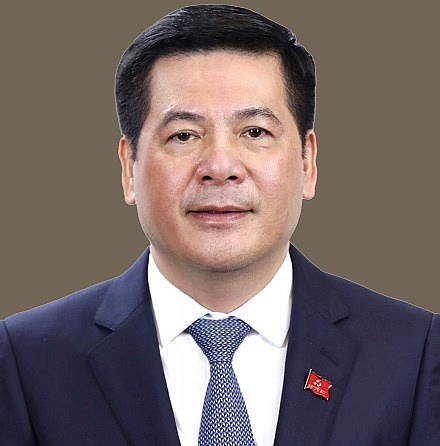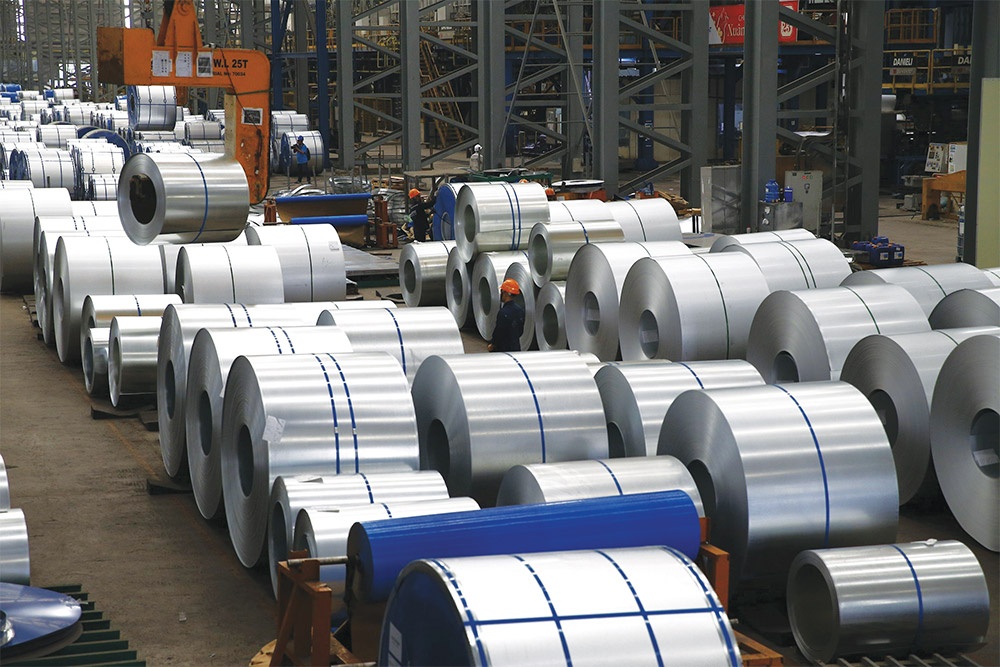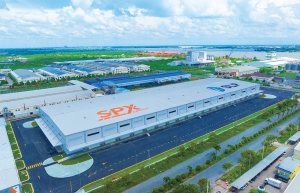A decisive year to realise nation’s industrial goals
Last year witnessed unprecedented difficulties seen in industrial and exports for the Vietnamese economy. Could you elaborate on this?
 |
| Nguyen Hong Dien, Minister of Industry and Trade |
In the context of the world economy in 2023 continuing to face massive difficulties with complex, rapid, and unpredictable fluctuations, global trade only increased by 0.8 per cent, down by half as compared to the 1.7 per cent forecast by the World Trade Organization at the beginning of the year.
Rising global prices of input materials, energy, and logistics have impacted businesses’ production costs. Although the inflation situation in many countries around the world has decreased, it is still standing at a high level, leading to the trend of saving spending and shopping in some large consumer markets such as the US and EU, causing a reduction in import demands.
China’s reopening has also created a lot of competitive pressure on Vietnamese exports. Trade protectionism and price competition among exporting countries with the same products have increased. Countries have applied more and more technical barriers, and created new pressures for imports. This has had adverse impacts on Vietnam’s domestic industrial production and trade, especially export activities.
But towards the second half of the year, the economy gradually regained its growth momentum, especially the industrial sector. It adapted better to the world’s new situation, in which many issues still remaining, especially the impact of adverse external factors and internal limitations and weaknesses that have existed for many years.
Thanks to timely solutions and actively taking advantage of opportunities from the recovery of large and traditional markets, our country’s export activities have been maintained and promoted. Exports and imports are estimated at $355.5 billion and $327.5 billion, respectively.
In particular, the economic growth hit 5.05 per cent, which is very positive in the context of the low growth rate of the world economy (2.9 per cent), the EU (0.8 per cent), or in Southeast Asia where only the Philippines had higher growth.
Although Vietnam’s exports in 2023 failed to reach the initial target, the economy reaped a record trade surplus. What was the reasoning for this?
The total export-import turnover for the year was estimated at $683 billion, down 6.6 per cent compared to the previous year, with value reduction of 4.4 per cent in exports and 8.9 per cent in imports.
However, though this trade growth rate is far from expectation and also fails to hit the target set for 2023, Vietnam’s goods exports have overcome difficulties, significantly narrowing the decline at the end of the year compared to the beginning of the year. This has demonstrated the Ministry of Industry and Trade’s (MoIT) efforts in export management.
One of the noteworthy achievements in the import-export picture in 2023 is that the trade balance continued to enjoy a surplus for the eighth year in a row, with an estimated value of $28 billion, contributing positively to the economy’s balance of payments, helping to increase the foreign exchange reserves, and stabilise the exchange rates and other macroeconomic indicators of the economy.
As for export results and trade surplus in 2023, these numbers should be seen in a positive angle in relation to global economic and trade performance. At the end of the first quarter, exports decreased by 11.8 per cent compared to the same period of the previous year. Since the end of the second quarter, exports showed signs of recovery month after month.
By the end of Q3, export value narrowed to an 8.5 per cent dip over the same period and only 4.4 per cent on-year for the year. It is clear that, as compared to the decline in export turnover of other countries in the region, our country’s exports have had a more positive recovery.
In the face of an unfavourable and unpredictable global trade context and increasing barriers from overseas markets, how will the industry and trade sector manage to manage export and import activities?
In fact, difficulties in trade in goods appeared since the end of 2022 and became increasingly difficult in 2023, especially in the early part of the year.
However, when we in 2022 earned an estimated export turnover that was up 10.6 per cent compared to 2021, there were some quite optimistic assessments about the prospects of 2023, but the MoIT then discovered the problem early. It directed its units, especially the overseas trade office system, to conduct early research and evaluation in order to capture fluctuations in key export markets.
We were able to make early identification and accurate prediction of the difficulties of the world economy from the early days of 2023 so that we could provide timely consultancy for the government to formulate proactive and flexible scenarios.
Last year, the MoIT organised a conference to promote domestic production and consumption and expand export markets. Along with fair events, trade connections were also implemented domestically and in key foreign markets such as China, Thailand, and Europe. The meetings between the MoIT with Vietnamese overseas trade offices were renewed with many breakthrough innovations in line with the government’s major policies.
The MoIT has conducted frequent updates on developments in export activities at border gates so as to have timely solutions and proposals to remove obstacles for the smooth flow of goods.
Since the beginning of last year, the MoIT has directed authorised agencies and businesses to make careful preparations and seize opportunities, especially in terms of the reopening of the Chinese border.
The MoIT’s departments and agencies also closely followed and ensured the progress of customs clearance of agricultural goods at northern border gates after the Lunar New Year. They also coordinate with ministries, sectors, and localities to promote full-tax export activities.
 |
Meanwhile, in order to achieve the export growth target of 6 per cent and a trade surplus of $15 billion, what scenarios have the MoIT formulated?
This year will play a decisive role in accomplishing the goals set in the country’s 2021-2025 socioeconomic development plan, especially in a context forecasted to continue to see many difficulties. Although the world economy has recovered, it is still slow and contains many uncertain and risky factors.
The MoIT will focus on resolving bottlenecks and difficulties, while supporting businesses to recover and develop production, especially in the processing and manufacturing industry.
We will also accelerate the implementation of industrial, energy, and trade development projects, especially key projects so that they can soon be put into operation, contributing to improving the competitiveness of the economy.
Moreover, we will also prioritise the development of a number of key industries, new technologies, and high technologies, such as chip manufacturing, semiconductors, mineral exploitation, and processing, to become a new driving force to promote the development of the processing and manufacturing industry.
Besides that, we will also continue to promote the role of the system of Vietnamese trade offices abroad in supporting localities and businesses to effectively exploit free trade agreements of which Vietnam is a member to diversify markets and supply chains, and promote exports.
The MoIT will also provide consultancy for the government on negotiations and signing of new and upgrading trade deals with potential partners in the Middle East, Africa, and South America, creating motivation to strengthen trade and investment cooperation.
At the same time, we will also increase support for businesses to strongly shift to full-tax exports associated with brand building and promoting sustainable exports.
 | Reforms essential for industrial M&As The industrial property market in 2024 in terms of mergers and acquisitions faces optimism this year, with new rules likely to boost progress. |
What the stars mean:
★ Poor ★ ★ Promising ★★★ Good ★★★★ Very good ★★★★★ Exceptional
Related Contents
Latest News
More News
- Businesses ramp up production as year-end orders surge (December 30, 2025 | 10:05)
- Vietjet chairwoman awarded Labour Hero title (December 29, 2025 | 13:06)
- How to unlock ESG value through green innovation (December 29, 2025 | 10:03)
- AI reshapes media and advertising industry (December 29, 2025 | 08:33)
- FPT and GELEX sign deal to develop blockchain tech for global markets (December 29, 2025 | 08:29)
- Vietnam’s GDP forecast to grow by 9 per cent in 2026 (December 29, 2025 | 08:29)
- Women entrepreneurs are key to Vietnam’s economic growth (December 29, 2025 | 08:00)
- Vietnam's top 500 value-creating enterprises announced (December 27, 2025 | 08:00)
- The PAN Group shaping a better future with ESG strategy (December 26, 2025 | 09:00)
- Masan Consumer officially lists on HSX, marking the next phase of value creation (December 25, 2025 | 13:20)

 Tag:
Tag:




















 Mobile Version
Mobile Version